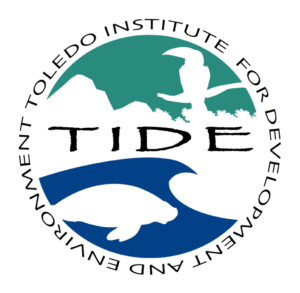ECOSUR Master’s student, Tránsito González Medina, supervised by TIDE science director James Foley, is carrying out a six-month manatee baseline population study at TIDE to improve understanding of the distribution and movement of manatees in Southern Belize. The research focuses on the behaviour, age classes, abundance and distribution of manatees in PHMR. One original reason for the establishment of PHMR was to protect manatees that had previously been hunted for their meat by local fishers, a history reflected in the TIDE logo, which features a manatee. Recent proposals by Providence Energy to conduct seismic testing and drilling for oil inside PHMR, PCNP and TIDE Private Protected Lands has underlined the importance of understanding baseline behaviour, distribution, population and habitat dependence of this IUCN-listed Vulnerable species.
The West Indian manatee comprises of two sub-species, the Florida manatee (Trichechus manatus latirostris), which migrates according to temperature variations, and the Antillean manatee (Trichechus manatus manatus), which is present in Belize and does not need to travel because of the low temperature variation in their home range.
Data is collected using boat patrols within selected areas of PHMR. Manatees come to the surface to breathe every 8-10 minutes and then slowly sink again to rest. González uses these opportunities to count and attempt to photograph individuals. The study has currently recorded over 100 manatee sightings and has photo-identified two adult females. By collecting spatial distribution data and identifying the areas of PHMR most used by manatees, the results could help to quantify current threats to manatees in PHMR, such as boat traffic and other human activities, by outlining potential risk zones. The next step will be to identify the individuals using photo-identification techniques and create a visual database of all manatees in the area.
The highlights of Transi’s research found that PHMR and PCNP maintain a healthy manatee population. Out of the 121 manatee sightings, around 10% seen were calves, which indicates a healthy reproductive population. Manatees were most frequently found feeding on sea grass beds in PCNP and Deep River, whereas those sighted around cayes tended to be resting. However, coastal areas in PHMR and PCNP are under threat from habitat loss and degradation of the manatee food source, sea grass, though development along the coast. Manatees are also killed and injured by boat collisions.
TIDE’s immediate response to the research will be to install more wake free zones in areas of high manatee presence. It is hoped satellite tagging devices will be attached to individuals in the future to record their movements. Also, research on sea grass beds in the area could help to protect their habitat.
TIDE wants to thank everyone for their hard work and dedication throughout the manatee project. We are so happy to finally understand more about manatee populations in the reserve. It has been a group effort; fishermen have collaborated and offered their local knowledge; TIDE’s rangers have helped carry out boat surveys; TIDE’s Marine Manager, Seleem Chan, Terrestrial Manager, Mario Muschamp, Assistant Terrestrial Manager and Science Director, James Foley, have coordinated the research and Transi has dedicated 6 months to the study. It is hoped this in-depth research will be continued on a larger scale in the future as it has the ability to help to reduce the negative impacts on manatees.
